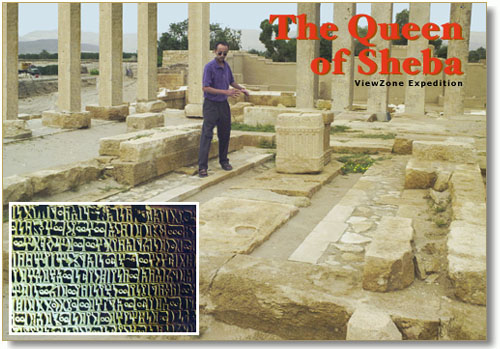 Sheba: The Ancient Empire The country Sheba or Saba, whose name means Host of Heaven and peace, was Abyssinia. Located in southwest Arabia on the eastern tip of the Red Sea, Sheba was thriving about 3000 years ago and occupied 483,000 square miles of mountains, valleys (wadis) and deserts in the area of present day Yemen. Some historians claim that Ethiopia, on the western end of the Red Sea, was also part of Sheba's territory.
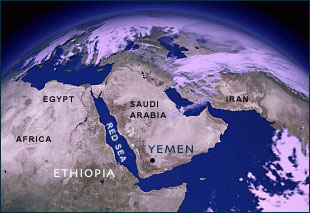 Sheba was a wealthy country with an advanced irrigation system. Its people, the Sabaeans, built dams as high as 60 feet with spans of almost a mile. They cut large earthen wells ito the Earth, which allowed them to irrigate their abundant gardens. Sheba was also rich in gold and other precious stones. But her real wealth was in her exclusive trade in frankincense and exotic spices sought by neighboring kingdoms. Sheba also had a very lucrative caravan trade. By 1000 B.C., camels frequently traveled the 1400 miles up the "Incense Road" and along the Red Sea to Israel. The Road began in the port of Al Mukulla and Bir Ali where ships would bring goods from distant India and the Orient. Frankincense is unique to Yemen since it is derived from the sap of a certain tree that grows only in Yemen. Frankincense was used as an offering to the gods and its rich perfumed smoke would rise like prayers to the heavens. It's aroma also made it valuable during cremations and it was often heaped on funeral pyres. Another Sabaean spice was Myrrh, an ingredient in fragrant oils and cosmetics. It was also used in preparing bodies for burial. The Sabaeans have been described as a tall and commanding people, both woolly-haired and straight-haired. Semitic in origin, they are believed to have been descendents of the Cush of the Bible. The sacred Ethiopian book which establishes the founder of the Ethiopian dynasty as the son of Solomon and Sheba, suggests that the Sabaeans were black. "Ye are black of face - but if God illumineth your hearts, nothing can injure you," priest Azariah says to the Queen and her people in the Kebra Negast.(1) Because of its isolation, Sheba was secure from military invasion for at least 500 years, and was independent and at peace with its neighbors during the 11th and 10th century B.C. History reveals that at least five kings preceded the Queen of Sheba - among them Iti'amra and Karibi-ilu. Yet Arabian documents portray all of Arabia as matriarchal and ruled by queens for over 1000 years. In Ethiopia, the Kebra Negast even refers to a law established in Sheba that only a woman could reign, and that she must be a virgin queen. Numerous legends refer to the female-centered clans, matriarchal practices, and matrilineal inheritance of ancient Arabia and surrounding countries. In Assyria, the head of a family was called the "shebu," and was originally a female, or matriarch. In other mideastern lands, polyandry was sanctioned - a woman could marry several husbands, who left their own families to live with hers; she could also initiate divorce by turning her tent to face east for three nights in a row. Before the onset of patriarchy, women may have experienced superior - or at least equal - rights with men. Since Sheba was a center of astronomical wisdom and the Queen or King was chief Astronomer and Astrologer. Religious life involved worship of the Sun and Moon. Shams was the Sun god. ViewZone visited the recently uncovered Temple of Shams in 2001 (photo below).
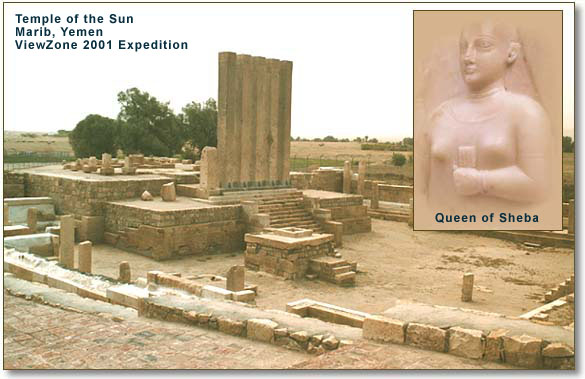 In the Kebra Negast, the Queen tells Solomon, "We worship the sun...for he cooketh our food, and moreoever he illumineth the darkness, and removeth fear; we call him 'our King,' and we call him 'our Creator'....And there are others among our subjects.... some worship stones, and some worship trees, and some worship carved figures, and some worship images of gold and silver."(2) The Great Goddess who dwelt in the sacred black aniconic stone was given the title Shayba by the Arabic-Aramaen people. Shayba represented the Moon in its threefold aspect - waxing, (maiden), full (pregnant mother), and waning (old wise woman or crone). But the primary Sabaean Moon god was Ilmukah or Ilumguh, identified with the god Sin of Assyro-Babylonian mythology. Sin was portrayed as an old man with an azure beard, the color of lapis lazuli, and a turbaned head. Wearing a crown shaped like a full moon, Sin rode a crescent moon-boat from which he navigated the night sky. Also called He-Whose-Deep-Heart-No-God-Can-Penetrate, he dispersed evil and darkness, and inspired his believers with dreams and prophecies. A Moon goddess worshipped by the Sabaeans was Astarte, or Ashtart, whom they called Astar, which means "womb." The giver and destroyer of life, Astar was Queen of Heaven and Mother of all Deities. Arriving from heaven as a ball of fire, and accompanied by a lioness, she was pictured with horns, and a disc of the sun above her forehead. The earliest known Arabian temple was at Marib, capital of Sheba, and was called Mahram Bilqus, "precincts of the Queen of Sheba." In Arab lore, this queen was named Bilqus or Balkis; in Ethiopia, Makeda (also Magda, Maqda and Makera), meaning "Greatness." Years later, the historian Josephus, referred to her as Nikaulis, Queen of Ethiopia and Egypt. ViewZone visited the site in 2001, but the following pictures (below) are from the University of Calgary Expedition in 2000. The site is now closed because of political unrest but already some astounding finds have been made.
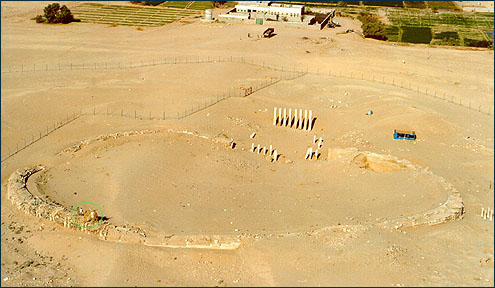 The site as it began to be excavated in Marib, Yemen. Most of the subsequent excavations focused on the area with the columns and part of the exterior wall. (Notice the people sitting on the wall to get an idea of the scale.) 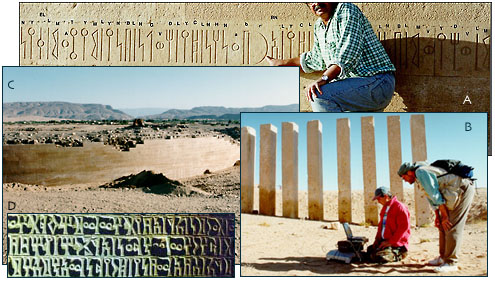 [A]- The mysterious writing on the exterior wall is examined. [B]- A team from the University of Calgary using ground penetrating radar. [C]- A view of the exterior of the oval wall that surrounds the Temple. [D]- One of several bronze plaques that appear to be a type of pre-cast, movable type. |
